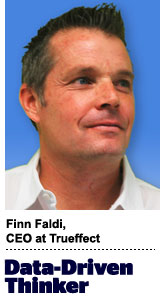
“Data-Driven Thinking” is written by members of the media community and contains fresh ideas on the digital revolution in media.
Today’s column is written by Finn Faldi, CEO at Trueffect.
Data has become the modern-day currency for brands to maintain a competitive advantage. As a result, brands have increasingly built entire infrastructures – a combination of people, processes and technology – to support an ecosystem of data that will yield valuable insights. The hope is to build better initiatives, drive better targeting and enhance consumer engagement.
A marketing and advertising tech industry has exploded over the past decade to support the trend, reaching as many as 2,500 companies ranging from display and search to video and native. Though there has been some consolidation, LUMA estimates that if there were 50 deals in one year, 75 new ones would emerge.
Brand marketing organizations need to keep up and ensure their teams have sharp, data and analytics superstars who can continue to crack the code behind the increasing flow of data.
Garbage In, Garbage Out
First and foremost, maintaining accurate data at the top of the marketing funnel, which sets precedent for all downstream stages, must be every brand’s top priority and remain core to how their marketing teams organize and operate. Imagine if marketing started with databases of inaccurate, non-standardized or duplicate data. The impact can be dire and snowball into costly waste when bad data flows through strategic campaign development, campaign execution, optimization and, finally, attribution. No matter which rock star data talent may live within the marketing organization, garbage data significantly impedes their ability to achieve what they set out to do.
To prevent garbage data at the top of the funnel, brands can implement various checks and balances in the beginning. The process can start with the chief marketing officer (CMO) setting clear standards and definitions with regards to what he or she deems as good, clean data, and holding the team accountable to established standards.
At this point, brands may find that they have a couple of criteria to consider: volume of data and quality of data. Despite what many companies claim, the highest level of data quality does not directly correlate to the highest volume. Therefore, it is up to each organization to decide where they would like to fall on the spectrum between volume and quality.
In the end, every company needs to be able to look clients in the eyes and transparently talk about its standards of data accuracy.
AdExchanger Daily
Get our editors’ roundup delivered to your inbox every weekday.
Daily Roundup
Smaller Data Sets Can Uncover Big Insights
As others have begun pointing out, small data can serve as an equally valuable tool for marketers in uncovering big, meaningful insights. Mid-size companies with limited resources can leverage a smaller set of more intimate, first-party data that may rival and even outmatch larger brands that rely on multiple data partners. Onboarding each new partner brings additional layers of complexity, not only into a brand’s organization, but also introduces new vulnerabilities into the database at the top of the funnel.
Before unleashing big data, CMOs should collaborate with their teams to determine the minimum number of attributes that will be sufficient to target the right consumers. Working off a smaller number of clean attributes and applying consistent data practices around those attributes can be significantly more efficient and accurate than working off a larger “dirty” data set.
Invest In People, Not Just Technology
Digital media organizations often host quarterly, bi-annual or annual sales and marketing summits to train these organizations of the latest solutions, messaging and upcoming initiatives. Not only are these summits educational, but they also result in increased employee morale, camaraderie among peers and other benefits.
Brands should also think about training their data analytics members in a similar way, and encourage ongoing education that will sharpen their skills as data continues to become the industry’s standard currency. As a sign of the times, the Interactive Advertising Bureau recently announced a new program called “Digital Data Solutions Certification.” It is described as “the official credential in digital advertising that demonstrates individuals have the knowledge needed to manage complex data programs for their clients and across their own companies.” These kinds of programs provide brands with the perfect opportunity to raise their analytics staff’s skills.
Brands today have seemingly limitless information to improve their programs and hone in on precise, highly targeted marketing strategies. But in order to take advantage of the massive incoming flow of data, brands need to ensure their organizations are set up to glean relevant, useful insights. By taking a strong stance on clean data, focusing on data efficiency and fostering a corporate culture of continued education, brands will be well positioned to maintain a leading edge in the marketplace.
Follow Trueffect (@Trueffect_Tweet) and AdExchanger (@adexchanger) on Twitter.












